Similar to many roofing products, roof coatings have evolved since first being used. Because of the benefits coatings offer, more building owners are requesting coatings be used on their buildings. When making roof coatings part of your company's offerings, learn how coatings began, are manufactured and should be applied.
Background
The first modern roof coatings were asphalt-based and referred to as "asphalt paint." Asphalt, a bottom-of-the-barrel byproduct of the petroleum refining process, became plentiful and cheap in the late 1890s when oil refineries sprung up to support the growing gasoline demand for the horseless carriage. By blending asphalt with petroleum solvents, a liquid material was created. The material could be painted on a variety of surfaces to provide protection from the elements and additional weathering protection. During the early 1900s, asphalt was used as a raw material to make roofing materials and could be heated and applied as a waterproofing adhesive.
It also was discovered that by adding fibers and fillers to asphalt paint, a variety of viscosities could be achieved to produce products for use with asphalt roofing materials. These products became known as asphalt roof coatings. Not long after, it was discovered aluminum pigment could be added to an asphalt/solvent blend to create aluminum paint and aluminum roof coatings. These coatings were used for decades.
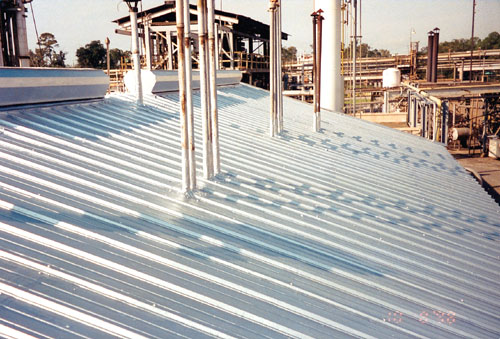
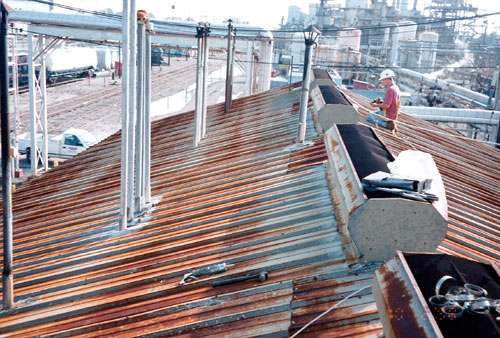
Photos courtesy of Metalcrafts Inc., Savannah, Ga., and MEGA Industries Corp., Jacksonville, Fla.
These before and after photos show the dramatic effects of roof coatings.
Currently, asphalt-based materials still are widely used, but the roof coatings industry is in the midst of a technological revolution.
Changes
With the introduction of roof membranes such as modified bitumen, EPDM, PVC, Hypalon® and substrates such as spray polyurethane foam (SPF) and metal, roof coatings have been developed to address membranes' and substrates' diverse adhesion, elongation and weathering characteristics. And as many building owners, facility managers and specifiers have become more knowledgeable about roofing, they are striving to extend their roof systems' service lives and reduce buildings' energy costs. The roof coatings industry has responded with more durable, highly reflective products to meet these interests and goals.
The U.S. Environmental Protection Agency (EPA) also has driven change in the coatings industry by continually tightening petroleum solvent volatile organic compound (VOC) emission regulations. These regulations require roof coating manufacturers and raw-material suppliers to provide a wide variety of high-performance roof coating products and systems to meet the lower VOC regulations and, at the same time, address the many changes in roof systems.
In the 1970s, the first generation of acrylic polymer-based roof coatings entered the scene, offering excellent elongation, tensile strength, adhesion and impact-resistance characteristics for use over SPF. More recently, polymers have been introduced that allow roof coating manufacturers to produce acrylic polymer-based coatings for use over built-up roof (BUR), modified bitumen, EPDM, Hypalon and other membrane systems.
The 1980s brought the introduction of urethane coatings, and, more recently, styrene-ethylene-butylene-styrene (SEBS) coatings have grown in use and popularity. Rubberized asphalt, silicone, Hypalon, EPDM and numerous other polymer-based coatings also have been introduced to the market. Future developments will bring other products to the market and refinements to existing roof coatings, which will increase the problem-solving options available to roofing contractors.
The basics
When manufacturing single-component roof coatings, the liquid, also called the carrier, is charged into a mixing vessel. The carrier typically consists of water (noncombustible), mineral spirits (combustible) or hot solvents (toluene or xylene, which are considered flammable). In addition to performing the carrier function, hot solvents also may be required to dissolve and maintain suspension of some polymers. Additional raw materials, such as polymers, pigments, tints or color oxides, fillers, fibers, surfactants, defoamers and mildewcides, then are mixed into the carrier depending on the end-use product desired. The mixing process and raw-material order of addition is referred to as the formula, or recipe. For viscous materials or in colder temperatures, heat may be required in the manufacturing process and vacuum processing may be needed for other products. After physical testing to ensure compliance with manufacturing and quality-assurance specifications, the finished liquid product is packaged in sealed containers to prevent carrier evaporation.
At job sites, after a thorough stirring, roof coatings are applied in a liquid state at a specified application rate, which results in a specified "wet mil thickness." As the carrier evaporates, the coating dries, leaving the solid polymers and pigments in place. When dry, this is referred to as the "dry film thickness." A constant in all applications is 1 liquid gallon (4 liters) applied evenly to 100 square feet (9 m²) of surface area is equal to 16 wet mils (0.4 mm).
For example, assume the specified application rate is 2 liquid gallons (8 liters) (32 wet mils [0.8 mm]) per square (0.8 liter/m²). What will be the dry film thickness? That depends on the roof coating's volume solids, which can be found in manufacturers' literature. For our example, let's assume a volume solids of 50 percent. Therefore, applying 2 liquid gallons (8 liters) (32 wet mils [0.8 mm]) onto a 100-square-foot (9-m²) area will yield 1 dry gallon (10 liters) (16 dry mils [0.4 mm]) of protection. This dry film is about 1/64 inch (0.4 mm) thick, or the thickness of three sheets of notebook paper. Interestingly, a typical house paint is applied to walls at a rate of 3 wet mils (0.08 mm). When you do the math, it is easy to see why roof surfaces are coated, not painted.
Obviously, the roofing industry requires a thin dry film thickness of roof coating to provide superior protection, and it does. But it is imperative for you to select products that best fit a specific project's requirements and apply roof coatings per manufacturers' recommendations and specifications.
To determine whether a coating meets a project's requirement, ask yourself the following questions: What is the existing roof membrane?; In what conditions are the membrane and flashing details?; Is the roof system currently leaking?; Should the wet insulation be removed and replaced?; What is the roof slope?; Are there heavily ponded water areas or just bird baths, and how will they be corrected?; In what season will the project start?; Is a warranty required?; Is Underwriters Laboratories Inc. or FM Global product approval required?; What is the owner's objective?; and Are metal roof systems rusted, and if so, how should rusted areas be handled?
Product selection
With a myriad of roof coatings available, how should you select the right product? Primary product selection will stem from the type of roof membrane or system to be coated. Search for products that will adhere to a given membrane or system. Also, consider other objectives, such as water resistance, life expectancy, warranties, energy savings potential, colors and the following issues.
Adhesion
If the selected roof coating will not adhere to the surface to be coated, you will be in the unenviable position of replacing the coating and/or facing a lawsuit. Neither option is favorable, so selecting the correct roof coating or system is critical. One or more coating adhesion tests, as prescribed by the coating or membrane manufacturer, should be conducted on the roof surface before coating application.
Typically, roof coatings adhere to surfaces by a combination of mechanical adhesion and chemical adhesion. This ratio varies depending on the coating being used and roof surface being coated, but typically, mechanical adhesion is predominant. Regardless, the surface being coated must be cleaned or adhesion will not occur.
Mechanical adhesion is the ability of a coating to physically grab onto a surface. For example, a granular-surfaced membrane provides a textured surface and most coatings will fill in between and around the irregular-shaped granules and provide an excellent bond. This does not address potential asphalt bleed-through and the fact that textured surfaces require more coating.
On the other hand, a smooth-surfaced asphalt membrane, which lacks granules, has microscopic surface irregularities and voids to which a coating can mechanically adhere. However, many roof coatings are thick and simply will span these surface areas. Therefore, the use of a thinner primer or primer/base coat is advisable to fill these irregularities and voids and maximize the mechanical bond.
In many instances, aged Hypalon membranes will have minor surface cracks that provide a good base for mechanical adhesion of a coating. A coating's chemical adhesion characteristics become more important with smoother-surfaced roof membranes, such as EPDM, which have few surface irregularities or voids.
Surface priming
To prime or not to prime? A roof coating manufacturer can provide guidance about priming. However, it generally is better to prime to ensure action has been taken to maximize coating adhesion.
A primer may have a lower viscosity than a coating. This allows the material to more easily flow into surface irregularities. A primer also may be formulated to enhance the chemical bond to a particular roof surface.
Because promoting coating adhesion is a primer's primary function, it usually is applied in a thin coat. Remember, all that is required is to maximize the coating adhesion—too much primer is a waste of material and labor and may be detrimental to the overall coating adhesion to the primer.
Primers and primer/base coats also may be used as stain blockers. For example, for metal roof system restorations, primers that contain rust inhibitors are available. For BUR and modified bitumen roof systems, primers and some coatings specifically are formulated to reduce or eliminate asphalt bleed-through and staining.
Water resistance
One common question asked about a roof coating is, "How does it perform under ponded water?" The roofing industry, recognizing the need to effectively remove water from roof systems, subscribes to a positive slope philosophy. However, roofing contractors regularly find ponded water.
A majority of high-performance, professional-grade roof coatings have good water-resistance capabilities in typical situations, such as under birdbaths. But beware of product performance in larger ponded water areas.
The NRCA Roofing and Waterproofing Manual, Fifth Edition, defines ponded water as the excessive accumulation of water at low-lying areas on a roof that remains 48 hours after the end of a rainfall under conditions conducive to drying. Many roof membrane manufacturers exclude ponded water areas from their warranties.
Recall the previous example where a 2-liquid-gallon (8-liter) (32-wet-mils [0.8-mm]) per 100-square-foot (9-m²) wet coating thickness provided a dry film thickness of 16 mils (0.4 mm) equating to an approximate thickness of 1/64 inch (0.4 mm). Now, think about the thickness of a three- or four-ply BUR or modified bitumen membrane. How can a 1/64-inch- (0.4-mm-) thick roof coating be expected to solve a ponded water problem? What can you do to correct the problem? You can add drains in low spots and build up crickets to channel water flow, etc. But these methods, though effective, are not always feasible.
Many high-performance roof coatings have good water-resistance properties that depend on the type of coating, application rate and number of coats applied. Good roofing practice dictates any wet roof insulation be replaced before a new roof system is installed over an existing roof system.
For a single-coat dry film coating thickness of 1 gallon per 100 square feet (0.4 liter/m²), water-based acrylic coatings have good water resistance but typically will—under long-term, heavily ponded water areas—wrinkle, blister and delaminate within about one year. At the same dry film coating thickness, solvent-based SEBS and urethane coatings tend to have better water-resistance properties. But again, a thin coat does not offer a long-term solution to ponded water problems. Applying multiple thin coats and perhaps adding a fabric membrane for reinforcement will enhance water resistances of high-performance roof coatings.
Never accept "Great!" as an answer to the question, "How does a coating perform under ponded water?" Instead, check coatings manufacturers' literature and warranty information and perform field tests. Ponded water should be addressed and eliminated.
Weather and temperature
Water-based coatings will cure best on warm days with low humidity. Water-based acrylics also are ultraviolet-curing. Therefore, in addition to warm temperatures and low humidity, direct sunlight enhances the curing process. Understandably, water-based coatings cannot be applied in freezing temperatures and require a minimum ambient air temperature of 50 F (10 C) and rising before application.
On the other hand, petroleum solvent-based coatings typically will not freeze and have lower minimum application temperatures than water-based coatings. Even at low temperatures, petroleum solvents will evaporate out of a wet coating though at a slower rate than on a warm day.
No matter what coating is used, rain on an uncured coating will cause a partial or total coating run-off. The work involved in the cleanup, not to mention the potential liability, is substantial. It is best to avoid coating on potentially rainy days or during rainy seasons.
Application
After products have been selected, coating application methods must be considered. Before applying a coating, you should think about the following issues.
Surface preparation
Adhesion has been identified as the primary factor in determining long-term roof coating performance. A dirty roof surface will not allow a coating or primer to adhere. Therefore, the roof surface or membrane to be coated must be completely clean.
Cleaning, in most cases, involves pressure washing the entire surface that will be coated with a detergent and water mixture at 2,000 pounds per square inch (psi) to 3,000 psi (13800 kPa to 20700 kPa). Aged, fragile membranes may require lower psi levels.
Chlorine bleach may be added to the mixture if algae and mildew are present. Additional surface scrubbing may be required on stubborn areas. The entire surface then should be rinsed with clean water and allowed to dry thoroughly.
Options
Before application, a coating must be completely stirred because the solids may have settled at a container's bottom. Stirring eliminates any settling and ensures proper polymer dispersion.
Using airless spray equipment is the preferred application method for roof coatings. Recommended equipment specifications and appropriate tip sizes can be obtained from roof coating manufacturers and will be based on products' formulas and viscosities. Spray application is the most economical method of application. Typically, a three-man crew is required.
First, a "spray man" is needed to evenly apply the coating using a spray wand. A second person, or "hose man," is positioned near the spray man and responsible for ensuring the hose's weight does not interfere with the spraying operation, as well as safely monitoring the spray man. Finally, a third person is required to operate the pump and equipment and maintain a steady coating supply. A three-man crew can apply up to 200 squares (1800 m²) or more of coating per day depending on the type of coating being sprayed, coating application rate, complexity of the roof shape and number of roof penetrations. On occasion, a fourth person will be needed if back rolling of the sprayed coating is required by the coating manufacturer.
In some cases, using a roller to apply the coating is more desirable. This might include situations where the roof surface is too small to justify setting up the spray equipment, space is not available for the spray equipment to be set up or there is concern about overspray.
Brush application is the least desirable application method because it is slow and labor-intensive. Additionally, particularly with thicker coatings, the brush application rate will be uneven, leading to thin spots, increased dirt pickup of the dry coating and excessive coating usage.
For all application purposes, two thin coats are preferable to one thick coat. For a thick coat application, typically in excess of 2 gallons per 100 square feet (0.8 liter/m²), the coating's surface may skin over prematurely and trap the remaining water- or petroleum solvent-based carrier. This may result in an uneven "cratering" of the coating surface or run-off from overnight rainfall or morning dew. On the other hand, multiple thin coats will allow for typical carrier evaporation; promote even polymer dispersion; and eliminate pinholes, voids, thin spots, etc., which may appear in the preceding coating application. For applications requiring two or more coats, successive coats should be applied at 90-degree angles to the previous coat to help ensure proper coverage.
Cool roof systems
Historically, a roof coating's primary function has been to provide a weathering surface and, in some cases, additional fire resistance for roof membranes or surfaces. Building owners now are beginning to ask for coatings to be installed because of other benefits, primarily energy cost savings and extended roof system lives. This marks a major change in the roofing industry. The interest in energy-efficient roof systems is in its infancy but growing rapidly as many building owners, specifiers and roofing contractors become exposed to energy issues.
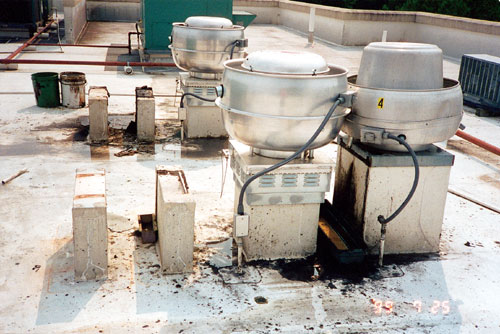
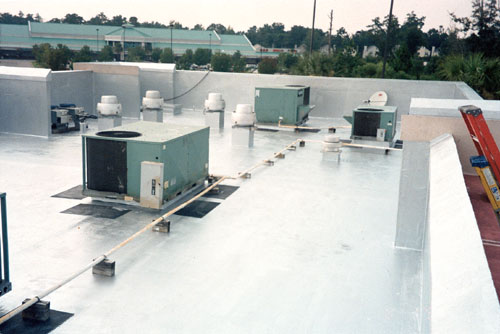
Photos courtesy of Metalcrafts Inc., Savannah, Ga., and MEGA Industries Corp., Jacksonville, Fla.
Many building owners request using roof coatings to extend their roof systems' service lives and reduce building energy costs.
For example, pretend it's a hot sunny summer day and you're standing outside between two cars. One is white, and the other is dark. You place your hand on the white car and notice the surface is warm but not uncomfortable. Then, you place your other hand on the dark car. It's hot, and you quickly remove your hand to avoid a burn. The white car is reflecting most of the sunlight, and the dark car is absorbing most of the sunlight and turning it into heat.
The same situation occurs on low-slope roof surfaces. It has been proved by Oak Ridge National Laboratory, Oak Ridge, Tenn., that the surface temperature of a dark roof system on a hot sunny day easily can approach 170 F to 180 F (77 C to 82 C) and a white or cool roof system may have a surface temperature of 110 F to 120 F (43 C to 49 C) (see figure). This is a dramatic 50-degree Fahrenheit to 70-degree Fahrenheit (10-degree Celsius to 21-degree Celsius) temperature difference.
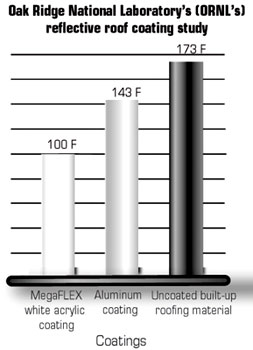
From June 1997 to October 2000, ORNL recorded roof surface temperatures of coatings over built-up and modified bitumen roof membranes. On July 3, 1997, the ambient outside air temperature was 97 F (36 C), and the temperatures of the roof surfaces are shown in the chart.
The primary benefits of installing a cool roof system—reduced cooling costs and extended roof system service lives—are just as dramatic. Actual cooling cost savings of 20 percent to 25 percent are common, and energy savings of up to 50 percent have been well-documented by EPA and other agencies. And by maintaining a roof surface or membrane temperature close to the ambient temperature, a roof system's service life is extended as heat aging and thermal shock are minimized. Studies still are in progress to determine the expected extended roof service life. For more information about the studies and cool roof systems, click here.
From an environmental standpoint, reduced cooling costs translate to reduced fuel usage, less power-plant emissions and fewer particulate matter in the air. And in urban areas, the cumulative effect of multiple cool roof systems will reduce the urban ambient temperatures and temperature-sensitive smog levels. In addition, landfill usage, to which roofing materials are a major contributor, will be reduced by extending existing roof systems' service lives.
More opportunities
As the number of roof coatings available has grown, so have application opportunities. Consider taking advantage of the fact that high-quality, commercial-grade roof coatings can be installed as part of a roofing company's maintenance program or for value-added new construction.
By learning the basics and strengths of each roof coating type, you can select the right product for each application, provide advantages to building owners and increase overall project profitability.
Allen Lancaster is president of Metalcrafts Inc., Savannah, Ga. He is a member of NRCA's Technical Operations Committee, Technical Services Group, Factory Mutual Contractor Approval Standard Task Force, and Metal Roofing and Sheet Metal committees. Woody Martensen is president of MEGA Industries Corp., Jacksonville, Fla. Martensen is a member of the Roof Consultants Institute and charter member of the Cool Roof Rating Council.
The benefits
For many years, the primary benefit of using a roof coating was to provide roof membrane protection. Now, with a vast array of coatings available, the number of benefits dramatically has increased. Following are some of these benefits:
- Roof membrane protection. Coatings protect roof membranes from ultraviolet degradation and typical weathering. For metal roof systems, coatings prevent metal from rusting and corroding further if existing rust is cleaned and primed before roof coating application.
- Extended roof system life. Because coatings protect membranes and metals, roof systems' service lives are extended.
- Fire resistance. Roof coatings can be formulated with fire retardants that maintain or reduce the flame-spread characteristics of certain roof membranes and assemblies. Many coatings and coating systems are listed with Underwriters Laboratories Inc. and FM Global.
- Energy savings. Highly reflective roof coatings significantly reduce building owners' air-conditioning costs depending on geographic location, existing roof insulation thickness and ceiling plenum construction.
- Lower membrane surface temperatures. As the amount of roof insulation R-value required in roof systems has increased, more heat builds up in membrane assemblies. Roof membrane service lives further can be extended with the use of highly reflective coatings because roof surface temperatures will remain closer to ambient outside air temperatures. It is not uncommon to see a 50-degree Fahrenheit to 70-degree Fahrenheit (10-degree Celsius to 21-degree Celsius) temperature reduction in surface temperature after coating a dark-colored roof system with a white, reflective coating. Therefore, the effects of thermal shock and heat aging (time period during which asphalt loses its elastic properties) of asphalt greatly are reduced.
- Water resistance. Roof coatings typically are not considered waterproofing materials. However, coatings serve as weatherproof surfacings when applied over spray polyurethane foam. Further, when used with other compatible materials, coatings can restore metal roof systems to watertight conditions.
- Aesthetics. Roof coatings are offered in a variety of colors to provide a more aesthetically pleasing roof surface or complement existing roof colors.
- Environmental. As noted, highly reflective roof coatings reduce roof systems' surface temperatures. According to the U.S. Environmental Protection Agency's ENERGY STAR® program, if a majority of roof surfaces in large cities were highly reflective, the overall ambient temperature in the cities would decrease. The result would be less energy use, fewer pollutants from power sources and lower smog levels.
Helpful resources
Cool roof system benefits are real. Those concerned about the environment actively are promoting cool roof systems, and government legislation advocating cool roof systems are being developed at federal, state and local levels.
Following are some Web sites that can provide information about facilities, organizations and standards associated with cool roof systems and energy efficiency:
- American Society for Heating, Refrigerating and Air-Conditioning Engineers Inc.
www.ashrae.org
- Cool Roof Rating Council
www.coolroofs.org
- ENERGY STAR®
www.energystar.gov/default.shtml
- Lawrence Berkeley National Laboratories, Berkeley, Calif.
https://eetd.lbl.gov/
- Oak Ridge National Laboratory Inc., Oak Ridge, Tenn.
www.ornl.gov/roofs+walls/facts/RadiationControl.htm
- Rohm and Haas Co., Philadelphia
www.rooftopics.com
In addition, Professional Roofing extensively has reported about the topics. Following are some related articles:
- "DOE issues determination for commercial building code," October issue, page 3
- "Roof surfaces and energy performance," November 2001 issue, page 30
- "Energy Star® update," July 2001 issue, page 60
- "It's not easy being green," February 2001 issue, page 28
- "Cool low-slope research," July 2001 issue, page 24
- "Revised thermal insulation requirements," May 2001 issue, page 56
- "Explaining Energy Star® to homeowners," May 2000 issue, page 70
- "Energy Star® Roof Products Program," January 1999 issue, page 53
- "Cool systems for hot cities," October 1998 issue, page 32

